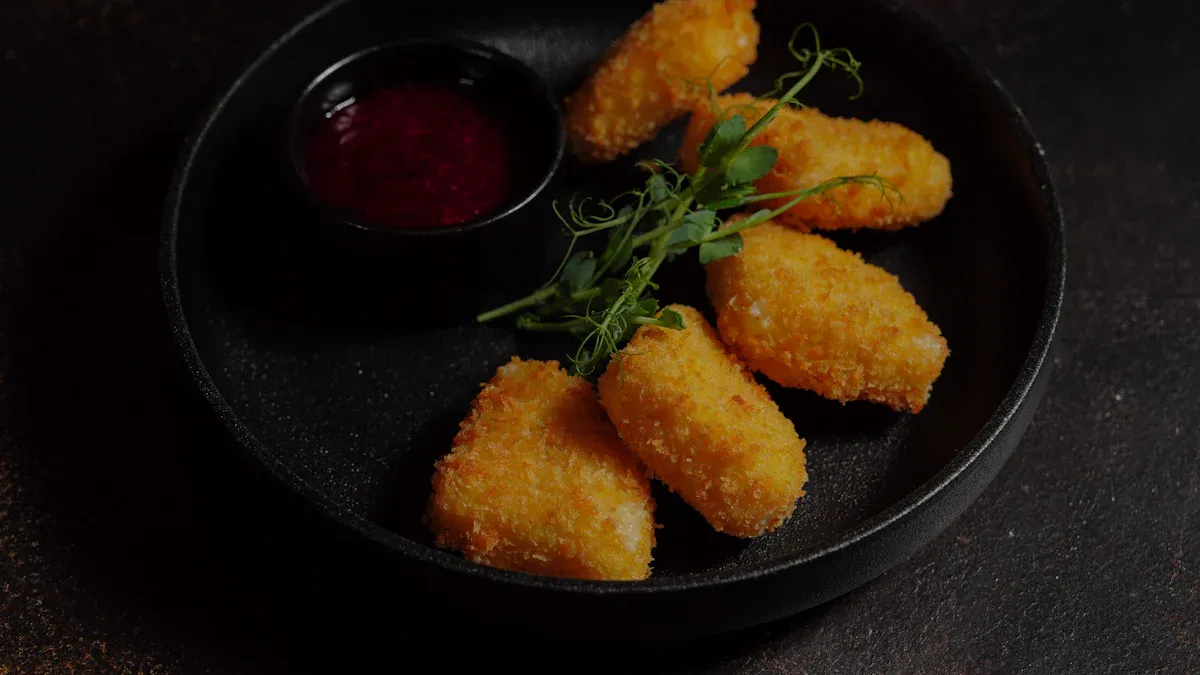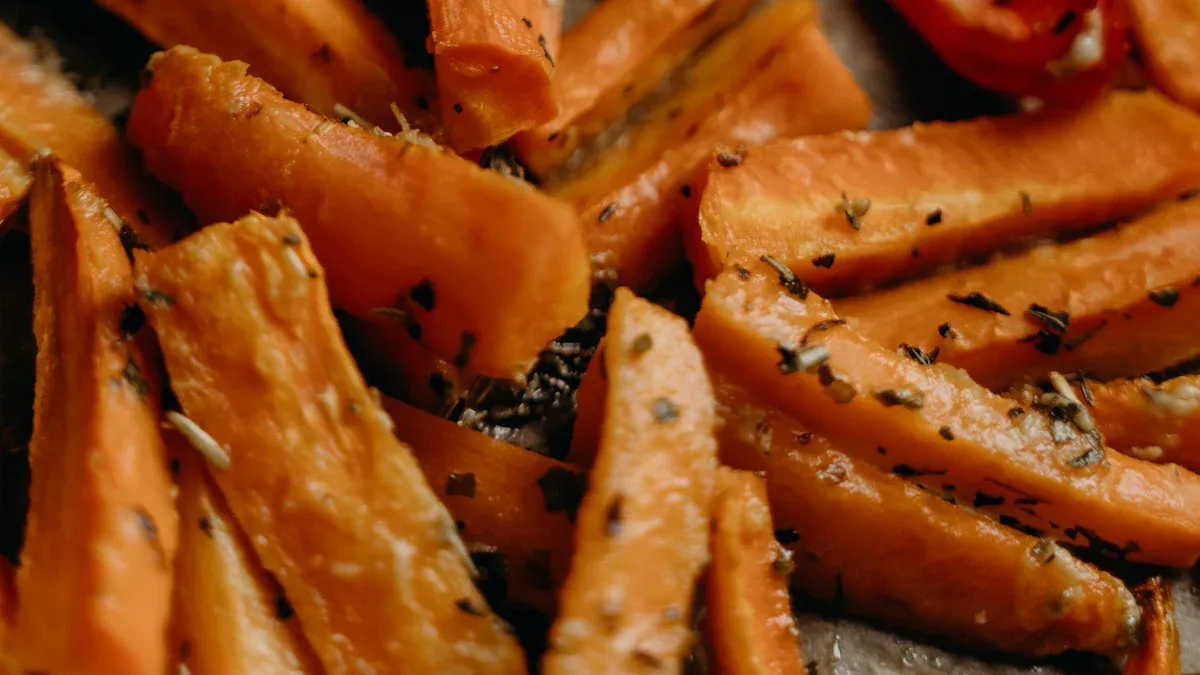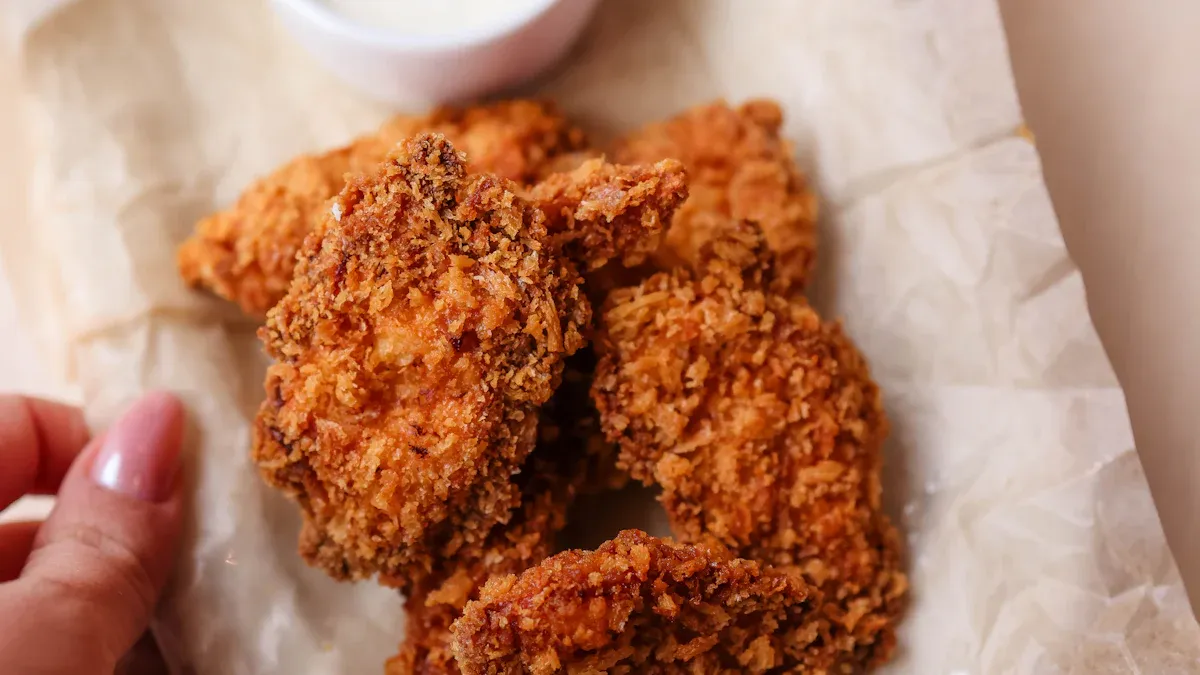
Crispy, oil-free dishes are a game-changer for home cooks. Whether it’s fries, chicken, or vegetables, appliances like air fryers and ovens make it possible. Air fryers, especially models like the dual two basket air fryer and the air fryer with double pot dual design, are gaining popularity. About 42% of adults now use them regularly for oil free air fryer cooking. They’re fast, efficient, and versatile, allowing for heating air fryer oven without oil. Meanwhile, ovens remain a classic choice for larger meals. But which one delivers the best results? Let’s explore.
Cooking Methods and Results

Heating Air Fryer Oven Without Oil: How They Work
Air fryers and ovens use different technologies to cook food without oil. Air fryers rely on rapid air technology, which circulates hot air around the food. This process mimics traditional frying by evenly browning the surface. They also use convective heat transfer, where fast-moving air replaces oil as the medium for cooking. Some models even incorporate far infrared radiation, which vibrates food molecules to generate heat from within. These mechanisms work together to deliver crispy results without the need for oil.
| Mechanism | Description |
|---|---|
| Rapid Air Technology | Circulates hot air for even cooking and browning, mimicking frying without oil. |
| Convective Heat Transfer | Uses air instead of oil, requiring faster air movement for similar effects. |
| Far Infrared Radiation | Vibrates food molecules to create internal heat for thorough cooking. |
Ovens, on the other hand, use radiant heat and convection fans to cook food. While they can achieve crispiness, their design often lacks the high airflow efficiency of air fryers. This difference explains why heating air fryer oven without oil tends to produce faster and more consistent results.
Which Appliance Produces Crispier Results?
When it comes to crispiness, air fryers often take the lead. Their superior airflow design and heat transfer efficiency remove moisture more effectively. This results in a golden, crunchy texture that’s hard to beat. Basket-style air fryers, in particular, excel in this area. They outperform air fryer toaster ovens in both crispiness and cooking speed, especially for foods like French fries.
- Basket-style air fryers deliver better crispiness than air fryer toaster ovens.
- Faster cooking times and greater moisture loss contribute to their success.
- Toaster ovens, while versatile, often fall short in achieving the same level of crunch.
Ovens, though versatile, may require longer cooking times to achieve similar results. Without a mesh basket or dedicated air fry settings, they struggle to match the crispiness of air fryers. For those who prioritize crispy, oil-free dishes, heating air fryer oven without oil is often the better choice.
Health Benefits and Oil Usage
Air Fryers and Minimal Oil Usage
Air fryers are a game-changer for those looking to cut down on oil. They use rapid air technology to cook food with little to no oil, making them a healthier alternative to traditional frying. This method not only reduces calorie intake but also lowers the risk of fat-related health problems. For example, air fryers can create crispy fries or chicken with just a fraction of the oil used in deep frying. The result? A similar taste and texture without the guilt. Many people find this feature appealing, especially when trying to maintain a balanced diet.
Ovens and Oil-Free Cooking Techniques
Ovens also offer oil-free cooking options, but they work differently. Baking, roasting, and broiling are common techniques that don’t require oil. These methods rely on radiant heat to cook food evenly. While ovens can produce delicious results, they often need longer cooking times to achieve the same crispiness as an air fryer. Adding a convection fan to an oven can help, but it still doesn’t match the efficiency of heating air fryer oven without oil. For larger meals, though, ovens remain a practical choice.
Which is Healthier for Everyday Use?
Both appliances have their strengths, but air fryers often come out on top for everyday health benefits. Here’s why:
- They significantly reduce calorie and fat intake compared to traditional frying.
- They maintain a crispy texture, making healthier meals more enjoyable.
- Ovens are versatile for large-scale cooking but may not offer the same health advantages for certain dishes.
For smaller portions and quick meals, air fryers are hard to beat. Their ability to deliver crispy, oil-free dishes makes them a favorite for health-conscious cooks.
Energy Efficiency and Cost
Energy Consumption of Air Fryers
Air fryers are known for their energy efficiency. They consume less power than traditional ovens, making them a popular choice for energy-conscious cooks. On average, a basket air fryer uses about 1.4 kWh, while an air fryer oven consumes slightly more at 1.8 kWh. To calculate energy usage, multiply the wattage by the hours of use and divide by 1000. For instance, a 1500W air fryer used for one hour daily consumes roughly 1.5 kWh. This efficiency stems from their compact size and faster cooking times, which reduce overall energy consumption.
| Type | Average Power Consumption |
|---|---|
| Basket Air Fryer | 1.4 kWh |
| Air Fryer Oven | 1.8 kWh |
Energy Consumption of Ovens
Ovens, while versatile, tend to use more energy than air fryers. Electric ovens typically operate within a range of 2.0-5.0 kWh, depending on the model and cooking method. Toaster ovens, however, are more comparable to air fryers, consuming between 0.8-1.8 kWh. Despite their higher energy usage, ovens can handle larger meals, making them ideal for family-sized portions or batch cooking.
- Air fryers consume less power than electric ovens.
- Toaster ovens offer similar energy efficiency to air fryers.
Cost Comparison: Initial Investment and Long-Term Use
Air fryers often have a lower initial cost compared to ovens. They also save money in the long run due to reduced energy consumption and faster cooking times. For example, cooking chips in an air fryer costs about 14.62 pence, while the same task in an oven costs 35.38 pence. Over time, these savings can add up, especially for frequent users.
| Item | Oven Cost (pence) | Air Fryer Cost (pence) |
|---|---|---|
| Cooking chips | 35.38 | 14.62 |
| Cooking chicken thighs | 35.38 – 47.16 | 16.08 – 20.47 |
Air fryers provide a cost-effective solution for smaller households or those looking to cut down on energy bills. Ovens, while more expensive to run, remain a practical choice for larger-scale cooking needs.
Size, Capacity, and Convenience

Space Requirements for Air Fryers
Air fryers are compact and fit well in most kitchens, even smaller ones. Models with a capacity between 2L and 5L are especially popular. They strike a balance between cooking enough food for an average family and not taking up too much counter space. This makes them ideal for urban kitchens where space is often limited.
In terms of dimensions, most air fryers measure between 12-15 inches in height, 8-12 inches in width, and 10-14 inches in depth. It’s important to leave extra space around the appliance for proper air circulation and to keep it away from water sources.
| Dimension | Measurement |
|---|---|
| Height | 12-15 inches |
| Width | 8-12 inches |
| Depth | 10-14 inches |
| Extra Space | Allow for air circulation and keep it away from water sources |
Space Requirements for Ovens
Ovens, on the other hand, require significantly more space. A standard residential range oven measures between 30 and 36 inches wide. Professional-grade ovens can go up to 60 inches, making them better suited for larger kitchens. While ovens offer more cooking capacity, their size can be a challenge in compact spaces.
| Oven Type | Size Range (inches) |
|---|---|
| Residential Range | 30 – 36 |
| Professional Range | 30, 36, 48, 60 |
Which is More Convenient for Different Lifestyles?
For those with busy lifestyles or smaller households, air fryers are a clear winner. They’re economical, easy to store, and quick to use. A survey found that 32% of U.K. air fryer owners noticed lower energy bills, and over a third reported eating out less often. Ovens, while versatile, are better suited for larger families or those who enjoy batch cooking. The choice ultimately depends on your kitchen space and cooking habits.
Pros and Cons of Each Appliance
Advantages and Disadvantages of Air Fryers
Air fryers have become a favorite for many home cooks, and it’s easy to see why. They offer several benefits that make cooking healthier and more convenient:
- Healthier meals: Air fryers require little to no oil, making them a great choice for those watching their calorie intake.
- Faster cooking times: They cook food about 25% faster than conventional ovens, saving both time and energy.
- Easy cleanup: Most air fryers have removable, dishwasher-safe parts, making cleanup a breeze.
- Versatility: From fries to chicken wings, air fryers can handle a variety of dishes while delivering a crispy texture.
However, air fryers aren’t perfect. They come with a few drawbacks:
- Limited capacity: Most models are compact, which means they’re better suited for smaller portions.
- Higher initial cost: Some air fryers can be more expensive than traditional ovens.
- Noise levels: Certain models can be noisy during operation.
| Product Type | Median Time to Reach 45% Moisture Loss | Median Crispy Fries (%) |
|---|---|---|
| Basket-Style Air Fryers | 00:17:07 | 68.7 |
| Air Fryer Toaster Ovens | 00:20:53 | 65.6 |
Advantages and Disadvantages of Ovens
Ovens remain a kitchen staple for good reason. They offer several advantages that make them indispensable for many households:
- Large capacity: Ovens are ideal for cooking bigger meals, making them perfect for families or batch cooking.
- Versatility: They can bake, roast, broil, and more, accommodating a wide range of cooking styles.
- Even cooking: Convection ovens, in particular, ensure food is cooked evenly and browned beautifully.
Despite their strengths, ovens have a few downsides:
- Longer cooking times: Compared to air fryers, ovens take more time to cook food.
- Energy consumption: They use more energy, especially for smaller meals.
- Drying out food: Without careful monitoring, some foods may lose moisture during cooking.
| Appliance | Pros | Cons |
|---|---|---|
| Air Fryer | – Healthier cooking option as it requires little to no oil | – Small cooking capacity compared to traditional ovens |
| – Faster cooking time | – Limited cooking options for larger meals | |
| – Easy to clean due to removable parts | – Can be more expensive than traditional ovens | |
| Convection Oven | – Even cooking and browning | – Can dry out some foods if not monitored carefully |
| – Large cooking capacity for bigger meals | – May require adjustments to cooking times and temperatures |
Both appliances shine in different areas. Air fryers are perfect for quick, crispy meals, while ovens excel in versatility and handling larger portions. The choice depends on your cooking needs and lifestyle.
Air fryers and ovens cater to different needs. Air fryers excel in speed, energy efficiency, and small meal preparation. Ovens shine in versatility and larger capacities.
| Aspect | Air Fryer | Oven |
|---|---|---|
| Cooking Speed | Faster cooking times | Slower due to larger capacity |
| Suitability | Best for small groups | Ideal for larger families |
Choosing the right appliance depends on your cooking habits and household size.
FAQ
1. Can you cook frozen foods in an air fryer or oven?
Absolutely! Both appliances handle frozen foods well. Air fryers cook them faster and crispier, while ovens are better for larger portions.
Tip: Preheat the air fryer for best results with frozen snacks.
2. Do air fryers use less electricity than ovens?
Yes, air fryers consume less electricity due to their compact size and shorter cooking times. They’re a great choice for energy-conscious households.
| Appliance | Average Energy Use (kWh) |
|---|---|
| Air Fryer | 1.4 – 1.8 |
| Oven | 2.0 – 5.0 |
3. Which appliance is easier to clean?
Air fryers are easier to clean. Most models have removable, dishwasher-safe parts. Ovens require more effort, especially for baked-on spills.
Note: Regular cleaning extends the lifespan of both appliances.


